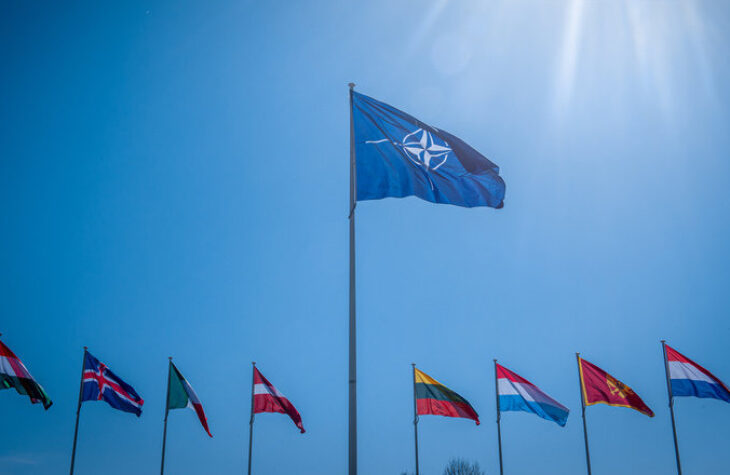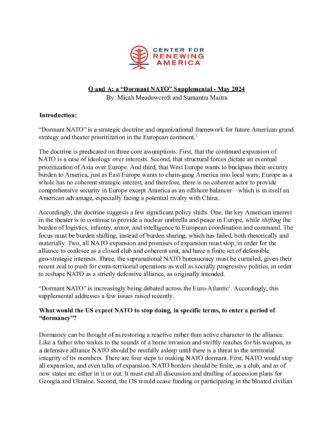
Q and A: a “Dormant NATO” Supplemental
Introduction:
“Dormant NATO” is a strategic doctrine and organizational framework for future American grand strategy and theater prioritization in the European continent.1
The doctrine is predicated on three core assumptions: First, that the continued expansion of NATO is a case of ideology over interests. Second, that structural forces dictate an eventual prioritization of Asia over Europe. And third, that West Europe wants to buckpass their security burden to America, just as East Europe wants to chain-gang America into local wars; Europe as a whole has no coherent strategic interest, and therefore, there is no coherent actor to provide comprehensive security in Europe except America as an offshore balancer—which is in itself an American advantage, especially facing a potential rivalry with China.
Accordingly, the doctrine suggests a few significant policy shifts. One, the key American interest in the theater is to continue to provide a nuclear umbrella and peace in Europe, while shifting the burden of logistics, infantry, armor, and intelligence to European coordination and command. The focus must be burden shifting, instead of burden sharing, which has failed, both rhetorically and materially. Two, all NATO expansion and promises of expansion must stop, in order for the alliance to coalesce as a closed club and coherent unit, and have a finite set of defensible geo-strategic interests. Three, the supranational NATO bureaucracy must be curtailed, given their recent zeal to push for extra-territorial operations as well as socially progressive politics, in order to reshape NATO as a strictly defensive alliance, as originally intended.
“Dormant NATO” is increasingly being debated across the Euro-Atlantic2. Accordingly, this supplemental addresses a few issues raised recently.
What would the US expect NATO to stop doing, in specific terms, to enter a period of “dormancy”?
Dormancy can be thought of as restoring a reactive rather than active character to the alliance. Like a father who wakes to the sounds of a home invasion and swiftly reaches for his weapon, as a defensive alliance NATO should be restfully asleep until there is a threat to the territorial integrity of its members. There are four steps to making NATO dormant. First, NATO would stop all expansion, and even talks of expansion. NATO borders should be finite, as a club, and as of now states are either in it or out. It must end all discussion and drafting of accession plans for Georgia and Ukraine. Second, the US would cease funding or participating in the bloated civilian NATO bureaucracy, with the expectation that NATO would eliminate anything not essential to basic European defense. There should be no official tweets about LGBT rights or support for social NGOs (e.g., Atlantic Council). Third, NATO would cease major antagonistic military exercises, especially in the Black Sea, recalling that it is a defensive alliance. Finally, there would be no further out of area NATO operations, whether in North Africa, the Middle East, or the Pacific.
What are the step-by-step mechanics of burden shifting?
Dormant NATO would give a fixed timeline for the removal of American artillery, armor, infantry, etc., out of the European continent. First step is the pull back of troops deployed to Europe by President Biden post-Ukraine war. Then the removal of the 10,000 President Trump wanted out in 2020. From there, finally, would be the more deliberate pull back of the “permanently” stationed forces in Germany, Italy, Balkans, and elsewhere. These will take more time and money because of the relocation of dependents and handover of major bases, but it will save money in the long run. There is already a template for shrinking American forces, from a peak of over three hundred thousand to around sixty in a span of five years, found in the reorganization following the collapse of the USSR.
Under a dormant NATO arrangement, nuclear forces and supporting Air Force assets would be retained in Germany and Turkey, and the 2nd and 6th Fleets would remain dedicated to Atlantic defense. But the rest of US conventional forces would be transferred either to continental America or to Pacific stations. The withdrawal can be extended or precipitous, depending on negotiations and global events, but a withdrawal is withdrawal and must be completed. For more, please see our addendum on troop withdrawal from Europe.
Which activities and organizational structures are conducive to the core NATO purpose of a defensive war and would be sustained in a “dormant NATO” scenario?
It is in the US national interest to maintain interoperability of forces with European allies. A dormant NATO should keep uniform standards for ammunition (5.56, 7.62, 120 mm for tanks, 155mm for artillery, etc.) to enable the US to be a logistics provider of last resort. Standards for tanks, satellite imagery, and other equipment should remain uniform. The focus should remain on defensive weapons, such as anti-aircraft units, surface-to-air missiles, and drone defense technologies as seen in the Ukraine conflict. To these ends some US participation in defensive joint NATO exercises would be expected to continue, led by European forces.
NATO’s nuclear command would remain solely in the hands of the US, with special structures and agreements maintained with regards to Britain and France’s nuclear arsenals and potential allied delivery of weapons in a crisis. While a dormant NATO would push Europeans to lead their conventional defense, there must be no further nuclear proliferation among member states. America will remain treaty bound to be the ultimate guarantor of nuclear deterrence for European states.
How should we understand America’s Article 5 obligations in a “dormant NATO” scenario?
Crucially, NATO’s Article 5 must be acknowledged not to supersede Article 1 of the US Constitution. Moreover, Article 5 does not oblige the US to take up all of the defense burden for Europe’s security; it merely brings NATO together to discuss a joint course of action in the case of its invocation. The only time Article 5 was invoked, after the September 11th attacks, member states came together to declare that, but the number of troops and contributions were left to the individual member states themselves. A similar principle applies, in reverse. If there is a land war in Europe, it is primarily a European responsibility to provide the bulk of the manpower and resources, and America to provide support. It goes against the Founder’s vision for America to be more willing and enthusiastic to provide manpower for Europe, than Europe herself.
However, if there is a nuclear war scenario over Europe, America is treaty bound and interested in eliminating a nuclear threat. That said, mutually assured destruction and general deterrence, or the nuclear lid on conflict, appears to still hold, as most recently restated by NATO Secretary General Jens Stoltenburg, so the threat of deterrence failure in Europe outside NATO, is primarily conventional, not nuclear.
Balancing Russia conventionally does not require US forward deployment; a united Europe is overwhelmingly stronger than Russia. Russian provocations in the Baltics can be deterred by positioning European forces, as well as police and counterintelligence operations. While interoperability of the member states would be maintained, should a conventional attack occur, the US—prepared to act as a backstop of last resort—would expect the European states to lead in providing troops, fighter aircraft, and other materiel.
What are the core security interests that NATO is guarding, which Europeans can protect largely on their own?
The European theater’s front is in the east, along the border with Russia, Belarus, and Ukraine. Russia is a revisionist power—i.e., with interests contrary to the status quo/American-led liberal international order—but with limited conventional or regional capabilities, which can be checked by the European rearmament and local alignments produced by the “dormant NATO” framework.
Russian capabilities, national interests, and known political intentions do not match a total confrontation with the NATO alliance as a whole. Under pressure, Europe has the industrial and financial capacity to build ground, air, and naval forces to effectively cover its front and flanks, especially considering Russian financial, manpower, and military limitations as revealed in the Ukraine conflict (plus considering its lack of an official alliance system of its own such as the Warsaw Pact). Consequently, there should be minimal concern about an overt Russian military action against a NATO member state, although Russia may seek to foment a regional internal crisis within the Baltics. That is a threat to be quelled by policing actions, primarily by European troops either stationed or patrolling the region, not by a general war.
NATO’s flanks are the Arctic and the Mediterranean. In the Arctic, primary threats are Russian and Chinese intelligence gathering. The southern flank’s core threat is mass migration from North Africa. Addressing neither of these problems requires American military power. European rearmament and counterintelligence operations can secure the European Arctic. The Mediterranean is a political question. Mass migration cannot be addressed without changing local welfare state incentives, alongside targeting human traffickers, sinking their boats, defunding NGOs, and taking strict legal action against anyone aiding and abetting the transportation of people; Europe will have to raze the human rights regime and asylum system currently in power, and, as an added deterrence measure, implement deportations. These are political and economic questions, for Europe to answer, and they do not require American military assistance.
Europe’s rear is guarded by the American, French, and British fleets. There are no major seaborne threats in that theater, and American naval operations guarantee its security apart from the activities of NATO. In sum, Russia is a regional threat, which can be balanced by European rearmament, policing, counterintelligence, and patrolling in Eastern Europe.
How are the interests of European NATO member states in tension with the American national interest?
NATO expansion has increased the risk of a general conflict with Russia, which is contrary to America’s interest, viz., the maintenance of a stable balance of power on the Eurasian landmass. Western Europe benefited from NATO expansion because it pushed NATO’s eastern flank further away from their national borders, creating a buffer between them and their major strategic threat, Russia. Newly added Eastern European states of course benefited from the security guarantees membership represented. None of this expansion was in the concrete US interest, and it was encouraged for misguided ideological reasons, often under the conceptual umbrella of an aspirational “democratic peace.”
More specifically, continued NATO expansion further committed the US to the European continent and consolidated America’s role as the primary guarantor of European security. This has enabled and incentivized Britain, Germany and France—the other three traditional candidates for regional great power status, along with Russia—to drastically underinvest in their own defense, undermining the conventional balance of power absent an American backstop. This expansion of the NATO club has also resulted in a diluted decision making process and increased potential defense burden, thereby reducing the utility of the alliance to America. Regardless of lofty rhetoric, the West European major states have all sought to pass the buck of their security burden to the US.
What is NATO’s role in a world dominated by great power conflict between the United States and China?
NATO should not be a factor in the American pivot to the Indo-Pacific, which is a major reason why Europe should take a greater role in it. The pressing national interest prompting the US to maintain a presence in Europe is not conventional military balance, which is currently stable, but maintaining trade and financial security alignment. The EU further joining a China-led economic sphere would potentially remove another major market for American firms; thankfully, the reverse holds true as well, such that Europe will likely retain an interest in trade with the United States even should political relations deteriorate.
The best case scenario for European-American relations during a general war in Asia or the Pacific is one in which the European powers will have stepped up to take the primary role in securing their own continent. In this scenario, the US would have succeeded in pulling back from the continent to free up assets for an Indo-Pacific conflict that previously were tied down in Europe. The worst case scenario for a Sino-American war is one in which the US is still too tied up in Europe and in which Europeans buckle to Chinese pressure to actually prevent the US from moving assets from NATO to the Pacific or from using European-based facilities to support the war effort. The latter dynamic has played out in the Middle East recently.
What act or failure to act should trigger a full withdrawal of the US from NATO?
A member state that picks war with Russia, inviting retaliation, will have voided the protection of Article 5. The election of governments in NATO member states that actively seek a conflict with Russia and agitate for one should also result in an American withdrawal. Recent calls for European powers to send regular troops into Ukraine, rather than advisors, are a reckless escalation. Such a mobilization would mark a formal entry into the conflict and a repudiation of NATO’s defensive character.
The refusal of Germany, France, or other large members of NATO to adequately fund their defense, or their public resistance to the transition to a “dormant NATO” posture, could result in a future scenario where, as then-Defense Secretary Bob Gates once warned, a future generation of Americans might not find it in the interest of the US to continue to subsidize European defense, eventually leading to a total US withdrawal from NATO. This includes any new promises made to expand NATO, in particular promises of accession to Ukraine and Georgia. Active potential interference in internal US electoral politics by NATO governments including taking sides in domestic debates on American foreign policy, might in future result in not only withdrawal from the alliance as a whole but sanctions on guilty member states.
Additional Resources
Policy Brief: Pivoting the US Away from Europe to a Dormant NATO
End Notes
- 1. See, Maitra. S, “Policy Brief: Pivoting the US Away from Europe to a Dormant NATO”, available at
https://americarenewing.com/policy-brief-pivoting-the-us-away-from-europe-to-a-dormant-nato/ February, 2023,
CRA. ↩︎ - 2. See, “Trump Plots to Pull Out of NATO — If He Doesn’t Get His Way” Rolling Stone, October 2023; “Europe must not be caught short if Trump wins again” Financial Times, December 2023; “Beware a world without American power” Economist, April 2024; “Fears of a NATO Withdrawal Rise as Trump Seeks a Return to Power” New York Times, December 2023; “Congress acted to protect NATO. But it might not be enough to stop Trump”, CNN February 2024; “Home alone: The sorry state of Europe’s plans for self-defence” ECFR February 2024; “The Trumpist Manifesto: The Republican struggle for a second-term foreign policy” ECFR December 2023; “How European Transatlanticists Might Approach an Isolationist U.S. Administration” CSIS February 2024, “For NATO to Thrive, Europe Needs to Wake Up” IPQ April 2024; “Flirting with Dictatorship” IPQ January 2024; “Trump II and US Nuclear Assurances to NATO” SWP April 2024; “Haben die Europäer wirklich geglaubt, die alte Nato habe auf ewig Bestand?” Der Spiegel February 2024; etc. ↩︎





